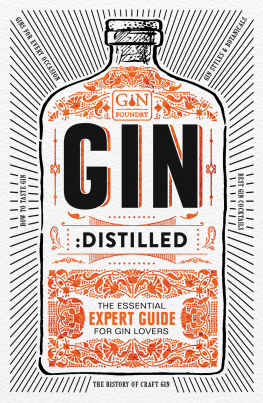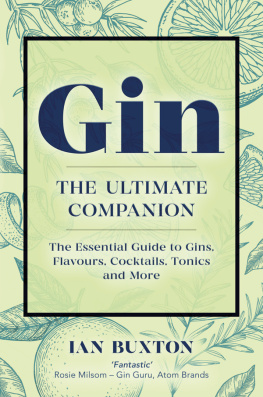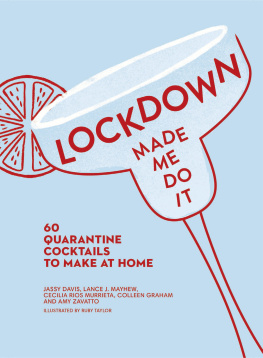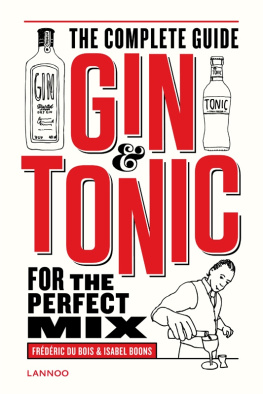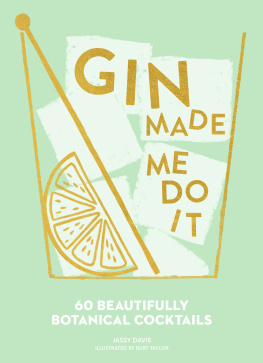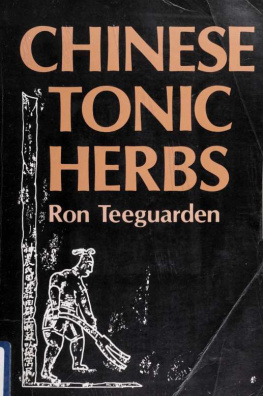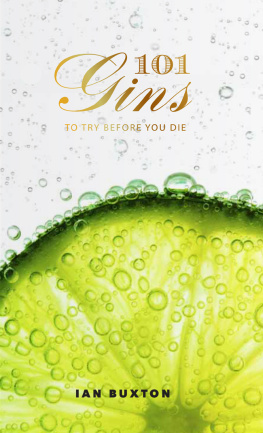
This ebook is copyright material and must not be copied, reproduced, transferred, distributed, leased, licensed or publicly performed or used in any way except as specifically permitted in writing by the publishers, as allowed under the terms and conditions under which it was purchased or as strictly permitted by applicable copyright law. Any unauthorized distribution or use of this text may be a direct infringement of the authors and publishers rights and those responsible may be liable in law accordingly.
Epub ISBN: 9781473563056
Version 1.0
1 3 5 7 9 10 8 6 4 2
Ebury Press, an imprint of Ebury Publishing,
20 Vauxhall Bridge Road,
London SW1V 2SA
Ebury Press is part of the Penguin Random House group of companies whose addresses can be found at global.penguinrandomhouse.com

Copyright Gin Foundry 2018
Cover design by James Jones
Olivier Ward has asserted his right to be identified as the author of this Work in accordance with the Copyright, Designs and Patents Act 1988
First published by Ebury Press in 2018
www.eburypublishing.co.uk
A CIP catalogue record for this book is available from the British Library
ISBN 9781529102857
Design by seagulls.net
Illustrations by Angeline Balayn
INTRODUCTION
There has never been a better time to enjoy gin in our opinion. Call it the Ginaissance, or the Gintrification of society (mainly to get the puns out the way and not return to them again) because gin has never experienced the highs it is soaring towards today.
The aim of this book is simple: to distil the world of contemporary gin into an accessible overnight guide. While the variety of gin on offer today is exciting, with more choice can come greater uncertainty what gin would you like in your G&T or Martini when you are faced with a menu of 30 options? How should it be served when more than one mixer or garnish is on offer? Is there a best way to drink different gins? This book hopes to act as a one-stop shop to demystify this glorious spirit and enable you to explore, experiment and enjoy gin with confidence.
There are so many varied and complex flavour profiles that push the category out from the classic juniper forward offerings of yesteryear. There has been a rejuvenation of old styles of gin, alongside the invention of new ones from all over the world, all of which cater to the tastes of the modern drinker. Well run through the different styles of gins available, the brands that showcase each style to its fullest, and how best to serve each one.
Youll find the modern history of gin here, as we put our focus on the rise of craft gin as we know it today. The history of gin stretches back to the sixteenth century, and there are many excellent books already written on its distant (and sometimes depraved) past. So here we have decided to look at the not-so-well-known story of gin from the 1950s onwards from gins fall from favour, to its resurrection by the big conglomerates, which eventually paved the way for the craft gin movement that has changed and reinvigorated the way we enjoy gin.
The explosion of botanical profiles means that the drinking and buying of gin can be approached in the same way as a fine wine. Moreover, understanding the different ways gin can be made is essential for knowing what youre drinking and defining what you like. We will cover how gin is made, discuss how to taste gin, what to look for when ordering or buying gin, and what to place a value on.
While we celebrate sipping gins here and the complex botanicals that define them, we dont put gin on a pedestal. Nothing is sacred when it comes to serving gin and home infusions are simply too good not to be included in this book. Finally, no guide to gin would be complete without some advice on how best to mix it and weve included the finest cocktail recipes here too.
We hope you enjoy the read, and well see you at the bar.
Gin Foundry
A PERFECT STORM: THE MODERN HISTORY OF GIN

The story of modern gin starts with its demise.
After its last hurrah in the fifties, what followed were decades of neglect and falling fortunes. The swinging sixties ushered in flower power, men on the moon, microwave dinners and pre-mixed cocktails. Gin, along with the bartenders craft of classic cocktail making, declined in favour of convenience experiences. When it came to booze trends, this didnt just mean vodka began its ascent, it meant gins almost complete eradication
Despite tense relations with Russia during the Cold War era, by the time of the tumble of the Berlin Wall and the Hoff prancing about in a piano keyboard scarf, even the holy grail of gin cocktails, the Martini, had become more commonly served as a Vodka Martini and made using a Russian spirit.
Fortunately, one gin prevailed in these dark times: Bombay Dry Gin. Launched in 1960, Bombay Dry was the brainchild of entrepreneur Allan Subin. Having previously worked in the drinks industry at Seagrams, the Madison Avenue based ad man had spotted the opportunity for a new gin brand. Inspired by some of the original gins of the late eighteenth century and, in particular, that of the pioneer Thomas Dakin (whose distillery is now known as G&J Distillers), he decided to create a gin that embodied the elegance of the 1920s and which had strong connections to English history both elements he knew would appeal to an American market.
Within five years, Bombay Dry Gin was achieving sales of over 100,000 bottles per year, which even by todays standards was an impressive start. This steady growth continued throughout the seventies (even forcing new stills to be commissioned to keep up production), despite it supposedly being a period in which gin was out of fashion.
Bombay Dry Gin was, unfortunately, the exception to the rule and the seventies were, for the most part, a flat line for most gin makers. Simply put, gin wasnt cool and hadnt been for years. By the eighties, the big drinks companies were almost entirely focused on the success of their flagship vodkas.
Thankfully, in a moment of daring brilliance, Bombay Sapphire was launched in 1988. With an updated recipe formula that built on the success of Bombay Dry, and packaged in what has since become an iconic blue bottle, it may not have been an instant success story, but it is clear that the brand captured the attention of a new generation. Years later, this is now widely credited as a turning point that marked the dawn of a new era.
T HE F OUNDATIONS FOR A C OMEBACK
The nineties were where much of the craft gin movement built its foundations. While it would be nice to be able to say that Bombay set a trend to premium-ise, it was such a novel concept that it was an outlier and it took years for marketeers to understand why it was successful and look to emulate it (something that can be seirthen in the noughties, more on this later). For the multinationals, gins comeback actually began with some shrewd economics in order to compete against the popularity of vodka. Gordons, Greenalls and Plymouth lowered their ABV to 37.5% and thus reduced the cost per bottle to make it a more affordable choice for consumers. Combined with a notable re-investment in marketing efforts, gin was moving back to the mainstream (albeit in a watered-down form and aimed at the cheap end of the market).
Next page
